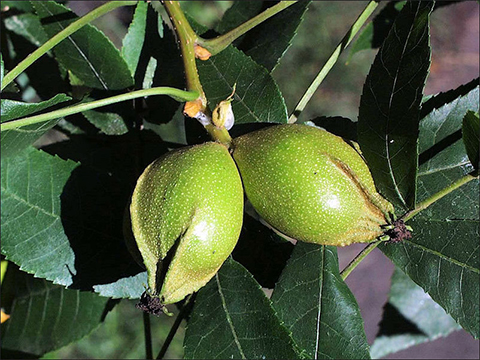 |
| Home | Ordering By Mail | Purchase Manual: Using Native Plants in Urban Landscapes |
|
|||||
Species Name: Carya cordiformis
Common Name: Bitternut Hickory
Zone: 4 to 9
Distribution: southern New York to Michigan in the north, south to Georgia and Texas
Seed collection: Collect nuts of bitternut hickory in September through October in New York. Nuts can be collected directly from the tree
beginning in early September or later from the ground as the nuts naturally fall. Nuts vary considerable in size on the same tree and between trees.
Evidence suggests that larger nuts produce larger seedlings so selectively collect the larger nuts.
Nuts are protected by a thin husk, that splits into 4 sections, that is firmly attached to the nut.
The husk splits and only partially peels away from the nut on some trees and remains firmly attached on others.
A fairly high percentage 70 to 80%.of the nuts are viable and produce seedlings according to tests conducted.
Trees produce large nut crops every 3 to 5 years. Open grown trees often reliably produce nuts every year.
Seed handling: Seed can be handled in one of three ways: plant nuts immediately in prepared seedbeds,
begin cold moist stratification for planting in the spring or plant outdoors in natural soils.
Nuts can be planted with the husk on if the husk is still firmly attached.
Germination requirements: Nuts generally germinate the first spring after planting in the fall or after cold moist stratification and planted in the spring.
Germination is quite variable and occurs from spring, throughout the summer and even into the fall.
It is likely that nuts planted but ungerminated will still germinate the following spring.
Ecology: Bitternut hickory (BH) has a wide distribution in the eastern US. It can be found growing on a wide range of sites from dry gravelly uplands
to deep bottomland forests. BH reaches its largest size and best growth on deep well-drained soils. It is a minor component of three forest cover types.
Its common associates are several other species of hickories and oaks in oak/hickory forests but it grows in mixed stands with many other hardwoods
such as sugar maple, beech, and basswood. Within its range, BH is restricted to the lower elevation of the mountains.
As the name implies bitternut hickory nuts are inedible to humans and although less preferred by wildlife than other hickory species,
the nuts inevitably get consumed by all kinds of animals from squirrels to deer.
Because BH is very adaptable to site conditions and is fast growing it should be considered for planted in most forest types.
BH definitely should be encouraged in the deep well drained soils where it grow best. It can reach 80 feet in height with a 2 ft diameter straight clear trunk.
Bitternut hickory also makes a beautiful shade tree or street tree.

Bitternut hickory nuts ready to collect.
this page posted February 25, 2015